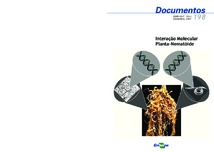Interação molecular planta-nematóide.
Interação molecular planta-nematóide.
Author(s): FRAGOSO, R. da R.; LOURENÇO, I. T.; VIANA, A. A. B.; SOUZA, D. dos S. de L.; ANDRADE, R. V. de; MEHTA, A.; BRASILEIRO, A. C. M.; PINTO, E. R. de C.; LIMA, L. M. de; ROCHA, T L.; SA, M. F. G. de
Summary: ABSTRACT: The endoparasitic sedentary phytonematodes of genera Heterodera, Globodera (known as cyst nematodes, CN) and Meloidogyne (the root-knot nematodes, RKN) are major crop phytopathogens, causing estimated losses of US$ 125 billion annually in the world. These plant-parasitic nematodes share some parasitism mechanisms, which ensure host-tissue invasion and host-defense evasion. The establishment and maintenance of the sophisticated molecular plant-nematode interaction are based upon several secreted molecules that access plant cellular processes, transforming them in enlarged, multinucleate, and metabolically active feeding cells. Nematicides applications are usually expensive, inefficient and environmentally hazardous. Crop rotation, bio-control agents and/or host resistance have not been successfully deployed against nematodes, except in some rare cases. Considering all limitations of nematode control, considerable attention have been given to the study of the molecular plant-nematode interaction, to obtain a comprehensive understanding of this patosystem, and to generate efficient alternatives to nematode control. The cultivation of resistant plants is the best control against nematodes, but this strategy is dependent on the existence and mapping of natural resistance genes, witch trigger hypersensitive response, for subsequent genetic breeding, limited to plants evolutively closely related. Other resistance mechanism observed is the production and accumulation of secondary metabolites with antimicrobial, nematicide and insecticide activities. Hundreds of plant genes that are differently expressed during nematode parasitism are already characterized, shading light on this patosystem at a molecular level. Despite several techniques that have been used for the study of plant-pathogen interaction, recent researches with inhibition of nematode gene expression, using RNA interference, have demonstrate the enormous potential of transgenic plants resistant to phytonematodes.
Publication year: 2007
Types of publication: Books
Unit: Embrapa Cerrados
Observation
Some of Embrapa's publications are published as ePub files. To read them, use or download one of the following free software options to your computer or mobile device. Android: Google Play Books; IOS: iBooks; Windows and Linux: Calibre.
Access other publications
Access the Agricultural Research Database (BDPA) to consult Embrapa's full library collection and records.
Visit Embrapa Bookstore to purchase books and other publications sold by Embrapa.

